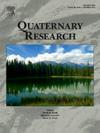德国西北部Schöningen中更新世Reinsdorf层序的景观动力学和年代学精细
IF 1.8
3区 地球科学
Q3 GEOGRAPHY, PHYSICAL
引用次数: 3
摘要
对Schöningen 13 II考古发掘遗址出土的新合成剖面(准参考剖面Schöningen 13 II和Zeugenblock 13 II[2018])进行了详细的沉积学、地球化学、孢粉学和水生微化石分析,反映了新记录的湖泊水位波动和植被变化的几个阶段。明显的森林砍伐和草本植物群落的扩张是间冰期森林群落之后的第一个草原(开放林地)阶段的特征。接下来的三个林地阶段主要以桦木和松木为标志,随后是另一个相当干燥的草原阶段和第二个林地时期,其中包括著名的考古“矛地平线”13 II-4ab。湖泊的逐渐干燥和向草原/苔原植被的转变表明了向寒冷期的过渡。基于植物学数据(宏观遗骸和形态)、陆生脊椎动物区系、地球化学、沉积学和先前建立的水生微化石数据,构建了Reinsdorf序列10个最具特征阶段的新型3D图像。此外,根据生物地层学和沉积学资料,提出了Reinsdorf层序后间冰期与海洋同位素亚阶段9d-9a的初步对比。本文章由计算机程序翻译,如有差异,请以英文原文为准。
Landscape dynamics and chronological refinement of the Middle Pleistocene Reinsdorf Sequence of Schöningen, NW Germany
Abstract Detailed sedimentological, geochemical, palynological, and aquatic-microfossil analyses on a new composite profile (Para-Reference Profile Schöningen 13 II and Zeugenblock 13 II [2018]) exposed at the archaeological excavation site of Schöningen 13 II reflect several phases of newly recorded lake level fluctuations and vegetation changes. A pronounced deforestation and the expansion of grasses and herbal plant communities characterize the first steppe (open woodland) phase, which follows the interglacial forest communities. A succeeding tripartite woodland phase predominantly marked by Betula and Pinus is followed by another rather dry steppe phase and a second woodland period, which includes the famous archaeological “spear horizon” 13 II-4ab. Transition into a cold period is indicated by progressive desiccation of the lake and a shift to a steppe/tundra vegetation. Novel 3D images of the 10 most characteristic phases of the Reinsdorf sequence have been constructed based on the botanical data (macro remains as well as palynomorphs), terrestrial vertebrate faunal, geochemical, sedimentological, and previously established data from aquatic microfossils. In addition, a tentative correlation between the post-interglacial phases of the Reinsdorf sequence and Marine Isotope Substages 9d–9a, based on biostratigraphical as well as sedimentological data, is proposed.
求助全文
通过发布文献求助,成功后即可免费获取论文全文。
去求助
来源期刊

Quaternary Research
地学-地球科学综合
CiteScore
4.70
自引率
8.70%
发文量
57
审稿时长
3 months
期刊介绍:
Quaternary Research is an international journal devoted to the advancement of the interdisciplinary understanding of the Quaternary Period. We aim to publish articles of broad interest with relevance to more than one discipline, and that constitute a significant new contribution to Quaternary science. The journal’s scope is global, building on its nearly 50-year history in advancing the understanding of earth and human history through interdisciplinary study of the last 2.6 million years.
 求助内容:
求助内容: 应助结果提醒方式:
应助结果提醒方式:


